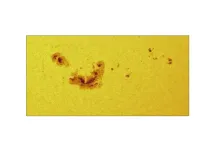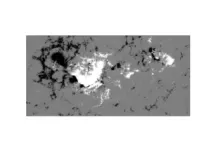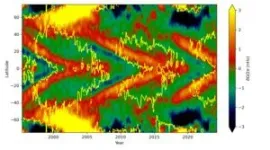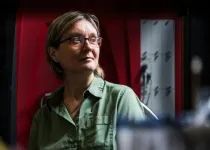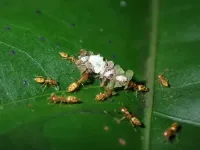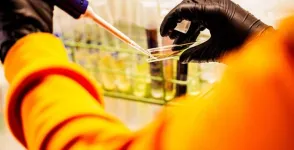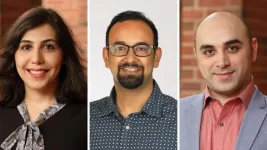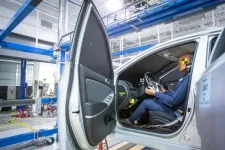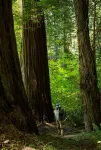(Press-News.org) Early riser! The Sun is already starting its next solar cycle – despite being halfway through its current one
Royal Astronomical Society press release
RAS PR 24/21 (NAM 7)
Embargoed until 00:01 BST on Friday 19 July 2024
The first rumblings of the Sun's next 11-year solar cycle have been detected in sound waves inside our home star – even though it is only halfway through its current one.
This existing cycle is now at its peak, or 'solar maximum' - which is when the Sun’s magnetic field flips and its poles swap places - until mid-2025.
It affects activity on the Sun's surface, with sunspots, flares and coronal mass ejections all more rampant at solar maximum. This leads to a surge in electromagnetic energy hurtling towards the Earth and makes aurorae visible more often and at lower altitudes.
The current solar cycle, named Cycle 25 because it is the 25th since 1755 when extensive recording of solar sunspot activity began, started in 2019.
It is not expected to end for another six years but the first signs that the next solar cycle is beginning have been spotted by researchers from the University of Birmingham and presented at the Royal Astronomical Society's National Astronomy Meeting in Hull.
Astronomers use the Sun's internal sound waves to measure how it rotates, making visible a pattern of bands (solar torsional oscillation) that rotate slightly faster or slower. These move towards the Sun's equator and its poles during the activity cycle.
The faster-rotation belts tend to show up before the next solar cycle officially begins.
Dr Rachel Howe and her international collaborators have discovered a faint indication that the next solar cycle is starting to show up in the data they have been analysing from the rotation bands.
"If you go back one solar cycle - 11 years - on the plot, you can see something similar that seems to join up with the shape that we saw in 2017. It went on to be a feature of the present solar cycle, Cycle 25," said Dr Howe, a research fellow at the University of Birmingham.
"We're likely seeing the first traces of Cycle 26, which won't officially start until about 2030."
Solar torsional oscillation signals have been studied using helioseismic data from the Global Oscillation Network Group (GONG), the Michelson Doppler Imager (MDI) onboard the Solar and Heliospheric Observatory, and the Helioseismic and Magnetic Imager (HMI) on board the Solar Dynamics Observatory since 1995.
The data now covers the first four years of Solar Cycles 23, 24 and 25, allowing researchers to compare the rising phases of these cycles.
Dr Howe has been following the changes in the Sun's rotation for about 25 years, when scientists only had a portion of data from Solar Cycle 23 from GONG and MDI.
They could see the pattern of faster-moving material drifting towards the equator along with the sunspots. Since then, they have watched the pattern repeat (but not exactly) as Cycle 24 came and went and again as Cycle 25 grew.
"It's exciting to see the first hint that the pattern will repeat again in Cycle 26, which is due to start in about six years.
"With more data, I hope we can understand more about the part these flows play in the intricate dance of plasma and magnetic fields that form the solar cycle," she said.
Media contacts
Sam Tonkin
Royal Astronomical Society
Mob: +44 (0)7802 877 700
press@ras.ac.uk
Dr Robert Massey
Royal Astronomical Society
Mob: +44 (0)7802 877 699
press@ras.ac.uk
Megan Eaves
Royal Astronomical Society
press@ras.ac.uk
Science contacts
Dr Rachel Howe
University of Birmingham
r.howe@bham.ac.uk
Images and captions
Big sunspot in 'white light'
Caption: Helioseismic and Magnetic Imager (HMI) image of the big sunspot that occurred on 5 May 2024, in continuum intensity ('white light').
Credit: NASA/SDO and HMI science team
Big sunspot in magnetic field
Caption: Helioseismic and Magnetic Imager (HMI) image of the big sunspot that occurred on 5 May 2024, in magnetic field.
Credit: NASA/SDO and HMI science team
Solar cycle map
Caption: This map shows which latitudes on the Sun were rotating faster (shown in red and yellow) or slower (shown in blue and green) than average over the last 29 years, as inferred by helioseismology (the analysis of solar sound waves). For each solar cycle, there is a band of faster rotation that moves down towards the equator. The yellow lines show the areas where the magnetic fields are most concentrated.
Credit: Rachel Howe
Solar cycle map (with text)
Caption: It is possible to see the whole of Solar Cycles 23 and 24, and the first half of Cycle 25. For each cycle, the band of faster rotation starts well before the magnetic activity for that cycle. On the far right of the figure, a bit of red marks what the team believes is the beginning of the fast-rotating band for Cycle 26.
Credit: Rachel Howe
Further information
Deployed in 1995, the Global Oscillation Network Group (GONG) is a global network of six identical telescopes, designed to have 24/7 observations of the Sun for use in space weather prediction and study of the Sun. The six observatories are the Teide Observatory (Canary Islands), the Learmonth Solar Observatory (Western Australia), the Big Bear Solar Observatory (California), the Mauna Loa Observatory (Hawaii), the Udaipur Solar Observatory (India) and the Cerro Tololo Inter-American Observatory (Chile).
Launched in 1995, the Solar & Heliospheric Observatory is an international collaboration between ESA and NASA to study the Sun from its deep core to the outer corona and the solar wind. Mission control is run by NASA at Goddard Space Flight Center in Maryland, US.
The Solar Dynamics Observatory is a NASA mission launched in February 2010 as part of the Living With a Star programme. Its focus is on solar activity, particularly observing the Sun's magnetic field.
Notes for editors
The NAM 2024 conference is principally sponsored by the Royal Astronomical Society, the Science and Technology Facilities Council and the University of Hull.
About the Royal Astronomical Society
The Royal Astronomical Society (RAS), founded in 1820, encourages and promotes the study of astronomy, solar-system science, geophysics and closely related branches of science.
The RAS organises scientific meetings, publishes international research and review journals, recognises outstanding achievements by the award of medals and prizes, maintains an extensive library, supports education through grants and outreach activities and represents UK astronomy nationally and internationally. Its more than 4,000 members (Fellows), a third based overseas, include scientific researchers in universities, observatories and laboratories as well as historians of astronomy and others.
The RAS accepts papers for its journals based on the principle of peer review, in which fellow experts on the editorial boards accept the paper as worth considering. The Society issues press releases based on a similar principle, but the organisations and scientists concerned have overall responsibility for their content.
Keep up with the RAS on X, Facebook, LinkedIn and YouTube.
About the Science and Technology Facilities Council
The Science and Technology Facilities Council (STFC) is part of UK Research and Innovation – the UK body which works in partnership with universities, research organisations, businesses, charities, and government to create the best possible environment for research and innovation to flourish.
STFC funds and supports research in particle and nuclear physics, astronomy, gravitational research and astrophysics, and space science and also operates a network of five national laboratories, including the Rutherford Appleton Laboratory and the Daresbury Laboratory, as well as supporting UK research at a number of international research facilities including CERN, FERMILAB, the ESO telescopes in Chile and many more.
STFC's Astronomy and Space Science programme provides support for a wide range of facilities, research groups and individuals in order to investigate some of the highest priority questions in astrophysics, cosmology and solar system science.
STFC's astronomy and space science programme is delivered through grant funding for research activities, and also through support of technical activities at STFC's UK Astronomy Technology Centre and RAL Space at the Rutherford Appleton Laboratory. STFC also supports UK astronomy through the international European Southern Observatory and the Square Kilometre Array Organisation.
Visit https://stfc.ukri.org/ for more information. Follow STFC on Twitter: @STFC_Matters
About the University of Hull’s E.A. Milne Centre
The E.A. Milne Centre for Astrophysics at the University of Hull brings together experts who study the evolution of structure in the Universe ranging from stars through to galaxies and galaxy clusters, right up to the largest structures in the cosmos.
The centre employs observations, theory and computational methods in collaboration with international partners. Postgraduate and undergraduate students work alongside staff to understand the wonders of the Universe. Through a series of outreach activities, the centre also aims to share its passion for astronomy and astrophysics with the region and beyond.
END
Early riser! The Sun is already starting its next solar cycle – despite being halfway through its current one
2024-07-19
ELSE PRESS RELEASES FROM THIS DATE:
Oakland hospital building is approved for construction
2024-07-19
Subscribe to UCSF News
Note to Editors: Photos and renderings are available in our Media Kit
UC Regents sign off on $1.5 billion project to construct a new hospital building at UCSF Benioff Children’s Hospital Oakland, securing the future of world-class pediatric facilities in the East Bay.
UCSF Benioff Children’s Hospitals has received final approval on a $1.49 billion hospital building on its Oakland campus that will provide a state-of-the-art, child-centered medical facility for families across the Bay Area. The proposal was approved ...
Rice’s Emilia Morosan awarded prestigious Vannevar Bush Faculty Fellowship
2024-07-18
Rice University’s Emilia Morosan has been selected as one of 11 scientists and engineers for the 2024 Vannevar Bush Faculty Fellowship (VBFF) to support her work on correlated topological materials. The fellowship is the Department of Defense’s (DoD) most prestigious single-investigator award and supports groundbreaking basic research with the potential to transform various fields.
The VBFF, a five-year fellowship with up to $3 million in funding, encourages innovative ideas where researcher creativity intersects with the unknown. Vannevar Bush Fellows represent a cadre of experts who provide invaluable direction to the DoD ...
DOE announces $52 million for small business research and development grants
2024-07-18
WASHINGTON, D.C.—In support of President Biden’s Investing in America agenda, the U.S. Department of Energy (DOE) today announced awards totaling $52 million for a broad range of small businesses in 39 states. The projects will work to solve a wide range of problems—from cybersecurity for electric vehicle charging infrastructure to new ways to detect radiation threats and new ways to manufacture lithium metal for batteries.
“Since Day One, the Biden-Harris Administration has supported small businesses, prompting record ...
Of ants and trees: ‘Evolutionary déjà’ in the tropical rainforest
2024-07-18
Ants are famous for their regimented and complex social behaviors. In the tropics, they are also famous for forming mutualisms with plants. Certain species of trees have conspicuous hollow swellings that house ants, often feeding the ants with specialized ant food. In return, the ants are pugnacious bodyguards, swarming out to aggressively defend the plant against enemies. Scientists have observed these mutualisms for centuries, but an enduring question is how these intriguing interactions evolved in the first place.
That remains a mystery, but new research led by University ...
Tumor-infiltrating lymphocyte therapy marks a milestone in cancer treatment
2024-07-18
TAMPA, Fla. — The recent U.S. Food and Drug Administration approval of lifileucel, the first commercial tumor-infiltrating lymphocyte (TIL) therapy for advanced melanoma, marks a significant breakthrough in cancer therapy. In a new commentary published in Cancer Cell, Moffitt Cancer Center scientists provide a comprehensive overview of the therapy’s development and highlight its transformative potential.
“TIL therapy represents a major advancement in personalized cancer treatment, offering new possibilities for patients with treatment-resistant cancers,” said Amod Sarnaik, M.D., ...
New research on climate change, gut health, and socioeconomic status’ impact on stroke and aneurysm care to be presented at Society of Neurointerventional Surgery’s 21st Annual Meeting
2024-07-18
FOR IMMEDIATE RELEASE: July 18, 2024
CONTACT: Camille Jewell, cjewell@vancomm.com or 202-248-5460
COLORADO SPRINGS, Colo. — Neurointerventional surgeons from across the globe will gather at the Society of NeuroInterventional Surgery’s (SNIS) 21st Annual Meeting from July 22 through July 25 in Colorado Springs, Colorado, to present novel research and innovation in their field.
The conference, held at the Broadmoor Resort, will be a hybrid event with in-person and livestreamed content. Meeting sessions will cover new topics ranging from how living in coal mining areas worsens outcomes ...
Statewide Biomedical and Clinical Research Collaborative Awards granted
2024-07-18
Researchers from the University of Tennessee Health Science Center College of Medicine-Knoxville; the University of Tennessee, Knoxville; and the University of Tennessee Health Science Center Office of Research understand the challenges affecting the health and wellness of Tennesseans. A new system-wide collaborative grant program led by UTHSC COM-K is supporting research and scholarly activities to pursue discoveries addressing health issues across Tennessee and beyond.
The program will fund six awards totaling more than $450,000 to support teams of clinicians, faculty, and researchers from across the state to innovate in the field of medicine and biomedical research.
Robert ...
First-ever hurricane evacuation order database may hold keys to future readiness
2024-07-18
A team of University of Virginia researchers released the first-ever database of hurricane evacuation orders in the United States. By examining what has worked (and hasn’t) in the face of oncoming hurricanes, leaders and government officials can increase community resilience, create better policy and, ultimately, reduce loss of life.
The project, seed-funded by UVA’s Environmental Institute, teamed Majid Shafiee-Jood and Negin Alemazkoor and Harsh Anand, an engineering doctoral candidate, from the School of Engineering and Applied Science. The trio spent countless hours gathering all nationwide public-facing evacuation orders and created a database that can ...
UVA researchers drive safety forward on 3 Toyota collaborative projects
2024-07-18
The Center for Applied Biomechanics at the University of Virginia studies the impact of car crashes on the human body, aiming to improve injury prevention. Funded by Toyota’s Collaborative Safety Research Center, CAB’s three newest projects will study rib, lumbar and ankle injuries specifically.
Jason Forman, a UVA Engineering and Applied Science research associate professor in the Department of Mechanical and Aerospace Engineering, is the principal investigator on two of the studies.
One study will use ...
Hundreds of new genome sequences fill gaps in the fruit fly tree of life
2024-07-18
A multitude of new genomic sequence data fills major gaps in the fruit fly tree of life, Bernard Kim from Stanford University, US, and colleagues report in the open-access journal PLOS Biology, publishing July 18th.
Fruit flies are classic model organisms in biological research and were among the first species to have their whole genome sequenced. With over 4,400 species, the diversity of the fruit fly family could offer insights into evolutionary patterns and processes. But only a fraction of these species ...
